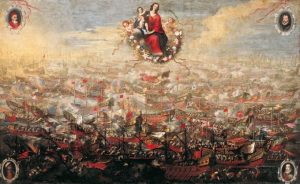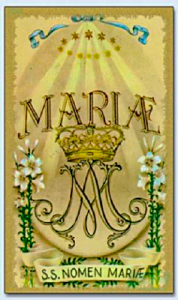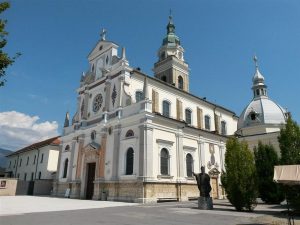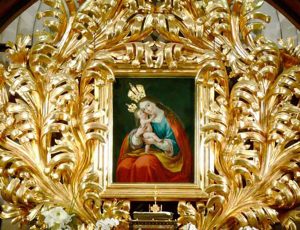
The Feast of the Holy Name of Mary, celebrated on September 12th, may not be as universally recognized as other Marian feasts like the Assumption or Immaculate Conception. Yet, it holds a rich history and offers profound insights into Marian devotion.
Join us as we delve into the origins of the feast, its history, how it is celebrated globally, churches and shrines dedicated to this devotion, and reflections from saints on the significance of Mary’s holy name.
Origins
 The feast traces its roots back to the Eastern Church but gained prominence in the Western Church after the Battle of Vienna in 1683.
The feast traces its roots back to the Eastern Church but gained prominence in the Western Church after the Battle of Vienna in 1683.
Led by King John III Sobieski of Poland, the Christian forces sought the intercession of the Blessed Virgin Mary and were victorious against the Ottoman Turks. To commemorate this victory, Pope Innocent XI extended the Feast of the Holy Name of Mary to the universal Church, choosing September 12th, the day following the victory, as its date.
The Battle of Vienna stands as a watershed moment in European history. It was not just a military conflict but a spiritual battlefield where faith met with providence. At the heart of this dramatic event is the belief in the miraculous intercession of the Virgin Mary, credited with tipping the scales in favor of the Christian forces led by King John III Sobieski of Poland. It remains an enduring symbol of faith triumphing over adversity.
Our Lady’s Triumph
The Battle of Vienna was a conflict between the Holy Roman Empire and the Ottoman Empire, which had been laying siege to Vienna for two months. The situation was dire for the besieged city, and a successful Ottoman capture would have had far-reaching implications for Christian Europe. It was in this desperate scenario that King John III Sobieski, leading a coalition of Polish and Germanic troops, arrived to lift the siege and push back the invading forces.
It is said that before engaging in battle, King John III Sobieski entrusted his forces and the outcome to the Virgin Mary. Prayers, hymns, and rosaries dedicated to Our Lady were offered up, imploring her intercession. The day of the battle also fell close to the Feast of the Nativity of the Blessed Virgin Mary (September 8), making the timing even more spiritually significant.
 Against overwhelming odds, the Christian forces achieved a decisive victory. King John III Sobieski himself attributed the triumph to the Blessed Virgin Mary. Upon entering the liberated city, he reportedly declared, “Veni, vidi, Deus vicit,” which can be translated to “I came, I saw, God conquered,” highlighting the divine intervention he believed had been instrumental in the victory.
Against overwhelming odds, the Christian forces achieved a decisive victory. King John III Sobieski himself attributed the triumph to the Blessed Virgin Mary. Upon entering the liberated city, he reportedly declared, “Veni, vidi, Deus vicit,” which can be translated to “I came, I saw, God conquered,” highlighting the divine intervention he believed had been instrumental in the victory.
In recognition of what was seen as the miraculous intercession of the Virgin Mary, Pope Innocent XI extended the Feast of the Holy Name of Mary to the universal Church, assigning it to September 12th to coincide with the miraculous victory.
In this context, the feast serves as an annual reminder of Mary’s powerful intercession and the role that faith can play in overcoming seemingly insurmountable challenges. The miraculous intercession of the Virgin Mary in this conflict serves as a powerful testimony to the enduring relevance of Marian devotion, especially in times of crisis.
Significance
 The Holy Name of Mary is revered not only as a name but also as a symbol of all the honor, devotion, and veneration we owe to the Mother of God. The feast is an opportunity to contemplate the virtues and holiness associated with Mary, inviting us to deepen our understanding and devotion to her.
The Holy Name of Mary is revered not only as a name but also as a symbol of all the honor, devotion, and veneration we owe to the Mother of God. The feast is an opportunity to contemplate the virtues and holiness associated with Mary, inviting us to deepen our understanding and devotion to her.
The largest celebrations of this Marian feast around the world include:
- Poland: Given the historical connection with the Battle of Vienna, Poland places significant emphasis on this feast. Pilgrimages to Marian shrines are common, and the day is often accompanied by Masses, hymns, and Rosaries dedicated to the Holy Name of Mary.
- Spain and Latin America: Processions and communal prayers often mark the day. Artistic representations of the name of Mary in flower arrangements or banners are sometimes displayed in churches.
- Philippines: Known for their strong Marian devotion, Filipinos often have special masses and sometimes even Marian parades to honor the Holy Name of Mary.
 Several churches and shrines worldwide are dedicated to the Holy Name of Mary, signifying the importance of this particular devotion. Two of the most notable include:
Several churches and shrines worldwide are dedicated to the Holy Name of Mary, signifying the importance of this particular devotion. Two of the most notable include:
- Sanctuary of the Holy Name of Mary at Brezje, Slovenia: A prominent shrine dedicated to Mary under this title.
- The Cathedral of the Holy Name of Mary in Minsk, Belarus: Another site that draws pilgrims specifically for this devotion.
Various saints have emphasized the power and significance of the name of Mary:
- St. Bernard of Clairvaux: “Look to the star of the sea, call upon Mary … in danger, in distress, in doubt, think of Mary, call upon Mary. May her name never be far from your lips, or far from your heart … If you follow her, you will not stray; if you pray to her, you will not despair; if you turn your thoughts to her, you will not err.”
- St. Alphonsus Liguori: “So great is the divine love for this glorious name, that God wills that even those who are only the servants of Mary should find special joy and consolation in pronouncing her name.”
Legacy
 The Feast of the Holy Name of Mary may not be among the most celebrated Marian feasts, but it carries a wealth of spiritual depth and historical richness.
The Feast of the Holy Name of Mary may not be among the most celebrated Marian feasts, but it carries a wealth of spiritual depth and historical richness.
Across various cultures and traditions, this feast encourages us to contemplate the virtues of the Blessed Virgin Mary and to invoke her name with reverence and love, assured of her powerful intercession.
Whether through the words of the saints or the dedication of shrines and churches, the importance of this feast stands as a testament to the universal and enduring appeal of Marian devotion.



